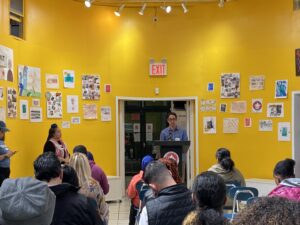During the week of May 10, New York City Mayor, Bill de Blasio, unveiled a series of transportation and open space-related policies and announcements through an initiative called Streets Week! As part of this effort, Mayor de Blasio announced that the Department of Transportation-run “Open Streets” program will become permanent. This is exciting news for the communities and small businesses across the City who have embraced streets as new spaces to gather, connect, and relax. Open Streets began a year ago as a COVID-related measure to expand safe access to outdoor space for residents and allow restaurants to reopen while following public health protocols. The announcement happens to coincide with another anniversary—2021 marks 60 years since the publication of Jane Jacob’s seminal work, Death and Life of Great of Great American Cities. While there is much in Jane Jacobs’ work that can and has been critiqued, complicated, and built on, including her discussions of race and class dynamics in the city, her investigation of streets, sidewalks, and city life has taken on new significance as people and cities around the world have rethought their relationship to outdoor public spaces as a result of the pandemic. So, what does Jane Jacobs’ work tell us about the importance of the Open Streets program?
In Death and Life of Great American Cities, Jacobs argues that “streets and their sidewalks, the main public places of a city, are [a city’s] most vital organs.” This was made abundantly clear as New Yorkers grappled with the pandemic. Early in the pandemic, while the City was under a shelter in place order, many lamented the emptiness of the City and predicted a grim timeline for NYC’s recovery. However, by the summer of 2020, residents and businesses were turning to parks and streets en masse to safely socialize, call for racial justice, and conduct business. People helped their neighbors by setting up community fridges, held outdoor fitness classes, and picnicked in record numbers. During this time, we saw first-hand the importance of active, vibrant street life to New York City’s identity and aura, leading residents and government leaders to develop new expectations around the role our streets and sidewalks play in daily life. We also saw how important businesses of all types are to bringing people out to the street. This is a core component of the Open Streets program and an element of healthy cities championed by Jacobs 60 years ago:
[Stores, bars, and restaurants] work in several different and complex ways to abet sidewalk safety. First, they give people—both residents and strangers—concrete reasons for using the sidewalks on which the enterprises face. Second, they draw people along the sidewalks which have no attractions to public use in themselves, but which become peopled and traveled as routes to somewhere else (Jacobs 36).
Jacobs references the bar on her street corner as an example of the way the consistent level of nighttime activity it generates makes her block feel safer to passersby. Today, outdoor dining, both on Open Streets and through the City’s Open Restaurant program, represents an extreme case of this scenario as bar and restaurant goers don’t just travel to and from the establishments they visit—they’re seated out front, offering a constant presence on the sidewalk. This dovetails into a second theory presented by Jacobs that has been borne out by New Yorkers’ collective experience during the pandemic: a love for people watching.
“The activity generated by people on errands, or people aiming for food or drink, is itself an attraction to other people…People’s love of watching activity and other people is constantly evident in cities everywhere” (Jacobs 37)
While the street and sidewalk space occupied by restaurants is now allocated to private businesses, the experience of dining has become more like that of sitting in a park or plaza—an experience often associated with the public realm. With Open Streets and Open Restaurants, diners are immersed in the life of the sidewalk and street—a car blasting music or bike messengers using the bike lane become an integral part of the dining experience. For example, when dining outdoors on Brooklyn’s Vanderbilt Avenue, restaurant goers can look up and simultaneously observe the patrons at other restaurants, the tangle of bicyclists and pedestrians navigating the street, and the local residents picnicking on the median. Love it or hate it, New York City in 2021 is a haven for people watching.
Restaurants have been left to navigate the tenuous divide between their space and the street and the subsequent lack of control over the ambience of their space on their own. Some have built more robust physical structures to divide customers from nearby traffic and many now offer more than one physical structure for customers to choose from. The pod- and igloo-like structures that popped up as the temperatures dropped last fall kept customers physically warm while also offering a more secluded or intimate dining option. Whatever course the restaurant chooses though, the street and restaurant are now intertwined, and seemingly will be for the foreseeable future.
The new relationship between private life and public space brought about by the pandemic will have far reaching implications for transportation planning, urban development, and economic development initiatives. Many of the inequities laid bare by the pandemic, from neighborhood air pollution levels to access to public spaces to the local collective bargaining capacity needed to apply for and run Open Streets, are interconnected, and solving them will require innovative partnerships from local businesses, residents, and elected officials. We are excited to see how these ideas transform New York City to create spaces that are safe, welcoming, and inclusive. Whatever form these changes come in, the success of the Open Streets program has shown that active, mixed-use streets have to be a part of any long-term solution, just as Jane Jacobs said 60 years ago.





 Public Works Partners is a WBE/DBE-certified urban planning and consulting firm. Our expertise lies in creating innovative, equitable, and sustainable solutions to complex problems.
Public Works Partners is a WBE/DBE-certified urban planning and consulting firm. Our expertise lies in creating innovative, equitable, and sustainable solutions to complex problems.